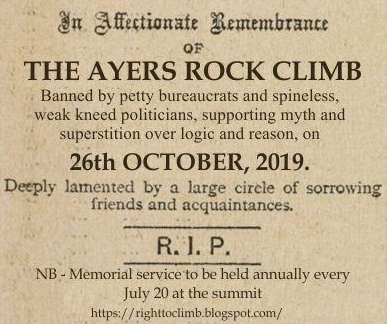
Marc Hendrickx, who has led a passionate crusade to keep Ayers Rock/Uluru open to climbers, tried to have the ad reproduced above inserted in the pages of the Age and SMH, which both rejected it. While things must be looking up at the former Fairfax rags, which can apparently afford to knock back ad dollars, Marc remains ropeable. He writes:
This is all wrong! The park board and the petty bureaucrats of Parks Australia have stolen my dreams for my children with their empty words and lies. How dare they! And yet I am one of the lucky ones. I was able to climb. My children, and their children and their children’s children will not be able to climb and share the joy and wonder of views listed as World Heritage by the United Nations.
How dare you!
For more than 30,000 years people have been climbing Ayers Rock. The first humans to see the Rock climbed it. Past Anangu owners like Paddy Uluru and Tiger Tjalkalyirri climbed it, and they were happy to share the climb with visitors. Since 1958 over seven million people, men, women, children, families and lovers have climbed it. They came from all over the world — and now you tell me that Anangu never climb? I am sick of your lies. How dare you
The lease agreement protects cultural heritage in the Park. It protects the climb. The World Heritage agreement protects the views. What is the point of protecting views if nobody can see them. How dare you!
You pretend the climb is especially sacred, even though Paddy Uluru and his brother said it wasn’t. Why do you make stuff up? How dare you!
You say the climb is dangerous when we know it is safer than a visit to the Grand Canyon or diving on the Great Barrier Reef. For people under 50 in good health the risk is the same as flying there. How dare you!
You say that less than 20 per cent of visitors want to climb when we can see with our own eyes what a nonsense that is.
How dare you say climbers are damaging the Rock when it has been there for 70 million years, and it will be there for 70 million more.
How dare you say climbers crap on the Rock. There is only one toilet around the Rock, where do you think the base walkers go? Do they carry excrement in their pockets?
How dare you blame visitors for management’s deficiencies.
How dare you deny the science in favour of animist nonsense. You eagerly trap generations in a cultural prison. How will they escape if they reject science because you won’t tell them about it?
Young people are starting to understand your betrayal. The eyes of future generations will be upon you. And if you fail us, we will never forgive you. This is where we draw the line. Change is coming whether you like it or not.
Almost alone, Quadrant has covered the history, culture and myths surrounding the Rock and the climb. That coverage can be accessed via these links.
 Sign In
Sign In 0 Items (
0 Items ( Search
Search








The banning of climbing on Ayers Rock is but one of several power plays by aborigines, encouraged by the black armband movement. More and more places in Australia can now be entered only by paying fees to aborigines or their corporations. If you want to see Mitchell Falls in the Kimberley, you now pay $45 for a five day pass to drive on taxpayer funded roads to see the Falls. You must pay a $50 aboriginal permit fee additional to the camping fee to camp at McGowans in the Kimberley, notwithstanding you have obtained, free, the necessary aboriginal permit to enter the area. You can no longer camp at One Arm Point or Chile Creek Camp, both on the Dampier Peninsular. The aborigines say they do not want to be bothered any more. They have moved into the Glamping tent accommodations at Chile Camp. The list goes on and on.
How about the idea that any road in Australia that has been and is funded by the taxpayer should be a gazetted road open to all who wish to use it without the need to obtain permits or pay a fee?
The banning of climbing on Ayers Rock is but one of several examples where aborigines are exerting their influence to the disadvantage of other Australians. More and more places in Australia can be entered now only by paying a fee to aborigines or their corporations, and in other places aborigines are denying access or the use of facilities. Examples abound in the Kimberley in WA.